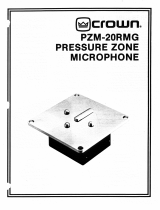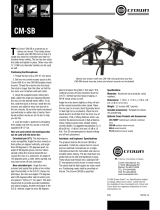
CM-200A, or a PZM-30D/PZM-6D set to “rising”
response. Also, move the mic around until you find a
spot where the monitored sound is bright.
How to achieve a good balance
A good balance is a good loudness relationship among
instruments and voice in a mix. When the balance is
good, no instrument is too loud or too soft. To achieve
a good balance when recording a large ensemble with
one or two microphones:
• Move instruments that are too quiet closer to the
mics, and vice versa.
• Place the mic(s) far enough away so that you don’t
emphasize the instruments in the center of the
ensemble.
• If you’re using two mics to record stereo, adjust the
microphone angling or spacing for a good balance. If
you hear a hole in the middle when using widely
spaced mics, add a third mic in the center, panned to
the center.
• If a soloist is performing in front of an orchestra,
raise or lower the orchestra’s mic stand to vary the
balance between soloist and orchestra.
NOTES ON CROWN
MICROPHONE MODELS
CM-200A
The CM-200A is a handheld condenser microphone
with a smooth, articulate sound quality. It’s great for
drums, guitar amps, and singing guitarists. Because of
its cardioid pickup pattern, the CM-200A rejects
sounds approaching the rear of the microphone.
CM-700
The CM-700 is a superb, cardioid condenser mic for
pro or semi-pro recording and high-quality sound
reinforcement. Rugged enough for the road, the
CM-700 works equally well for popular music (multi-
miking) or classical music (stereo and spot-miking).
The CM-700 has a clear, natural sound. Self-noise is
very low, and the mic can handle extremely loud
sounds without distortion. A bass roll-off switch, pop
filter and windscreen are included.
CM-150
The CM-150 is a
1
⁄
2
- inch diameter, omnidirectional
electret-condenser microphone. It has a very flat
response from 20 Hz to 20 kHz, so it sounds accurate
and natural. It preserves the delicate timbre of acous-
tic instruments yet can reproduce all the power of a
pipe organ.
GLM-100
This miniature omni mic offers all the quality and
wide-range response of larger studio microphones.
Since the GLM is small, it can be attached to instru-
ments to improve isolation and reject off-mic sound.
PZM-6D
The PZM-6D is a Pressure Zone Microphone. When
suspended over an orchestra on a clear panel, the
PZM practically disappears. Its miniature, perma-
nently attached cable also reduces visual clutter.
The PZM-6D has a switchable, dual frequency re-
sponse: rising or flat. The “rising” position adds
brilliance. This makes it useful wherever crisp attack is
desired, such as on percussion, drums or piano. The
user can get a bright sound without boosting high
frequencies on the recording console; the benefit is
lower noise. The “flat” position provides a smooth, flat
high frequency response for natural sound reproduc-
tion.
Like other Pressure Zone Microphones, the PZM-6D
uses the Pressure Recording Process in which a
miniature condenser mic capsule is mounted very
close to a sound-reflecting plate or boundary. The
capsule is in the “Pressure Zone” where sound coming
directly from the sound source combines in phase
with sound reflected off the boundary. The benefits
are a wide, smooth frequency response free of phase
interference, excellent clarity and “reach,” a hemi-
spherical polar pattern and uncolored off-axis re-
sponse.
PZM-30D
Same as the PZM-6D but larger. It accepts a rugged
detachable cable.
SASS-P MKII
The SASS-P MKII is a stereo microphone using PZM
technology. The unit makes excellent stereo record-
ings, has a natural tonal balance, is mono-compatible
and easy to use, and costs less than the competition. It
comes with a carrying case and a full line of accesso-
ries. Model SASS-P HC is the mic alone and costs less.
SPECIFIC APPLICATIONS
This section suggests some ways to place Crown
microphones to record various musical instruments.
These are just starting points to reduce the time
5















